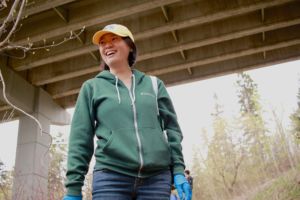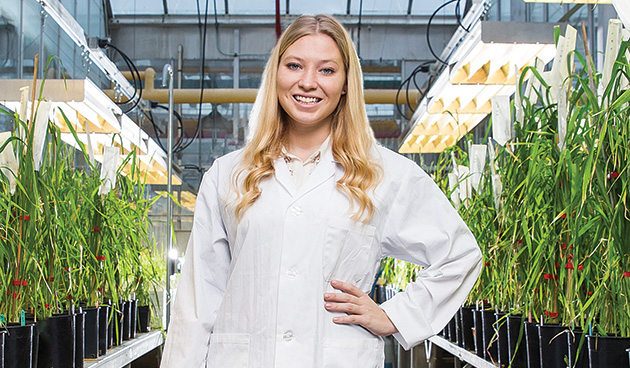[vc_row][vc_column width=”1/2″][vc_gallery interval=”3″ images=”458″ img_size=”568 x 568″ onclick=””][/vc_column][vc_column width=”1/2″ el_class=”Photo provided by Pamela Wight”][vc_column_text]Photo Credit: Photo provided by Pam Wight[/vc_column_text][vc_column_text]Pam Wight
Executive Director, Edmonton and Area Land Trust
https://www.ealt.ca
1) What would having constitutional environmental rights (e.g. the right to clean air, clean water, safe food, to access nature, etc.) mean to you, and/or your organization?
Most of my life I’ve been involved in environmental conservation and other aspects of sustainability (e.g., sustainable livelihoods, resource management, maintaining local cultures) in many countries. Having constitutional environmental rights shows that as a society, we want to treat the Earth like we’re planning to stay, and that we understand they’re an extension of other human rights. Other rights are dependent on a sustainable environment. The Rights of Nature were recognised 8 years ago, taking the concept of Environmental Rights to its logical conclusion. The Edmonton and Area Land Trust (EALT) as a nature conservancy could be a positive force in implementation and awareness.
[/vc_column_text][/vc_column][/vc_row][vc_row][vc_column][vc_column_text]2) What do you think people in Edmonton can and/or should do to further the cause of environmental rights?
Edmontonians can do many things for the environment: personal actions at home; advocating for environmental rights in social media; and influencing others – via politicians, friends, colleagues. And of course they can they can support organisations like EALT whose mandate is to protect the environment in perpetuity, by volunteering, stewarding, or other support. Everyone can take such actions, work with environmental organisations, advocate and influence – and enjoy the environment they are stewarding, as well!
Some provinces already have provincial bills of environmental rights. Edmontonians can support declarations of support for environmental rights and also take concrete personal actions.
3) What are you (or your organization/business/group) doing to further the cause of environmental rights?
EALT works on the land, boots on the ground, securing and stewarding natural areas forever. We do this for the benefit of citizens, wildlife, clean water and air, and all the services (which are often forgotten) that the environment provides (e.g., cleaning, pollinating, flood mitigation). EALT’s lands directly support breathable clean air, clean water, biodiversity, fertile soils, homes for wildlife, and access to nature for all.
More than this, we educate citizens on environmental topics via mainstream media articles, brochures, presentations, workshops, youth work, and partnerships. We also have developed the Earth Ambassador Award, since Edmonton has no environmental awards.
[/vc_column_text][/vc_column][/vc_row][vc_row][vc_column width=”1/2″][vc_column_text]4) 110 nations around the world recognize their citizens’ right to a healthy environment. Why do you think Canada hasn’t done this yet?
Canada is vast, and we take our environment for granted, thinking it has almost unlimited resources. Yet human impact is visible everywhere.
We’re resource rich, and focus on environmental resources (to exploit), rarely on environmental services.
Governments have focused on ‘growth’ rather than development, but growth is not sustainable, and shouldn’t be a goal.
Governments tended to view the economy as the pre-eminent sector, rather than built on the environment. They organize in activity silos (departments) instead of having an integrated, overarching vision. This separates environment from other sectors, and masks the fact that a healthy environment is interconnected and fundamental to all other sectors.[/vc_column_text][/vc_column][vc_column width=”1/2″][vc_gallery interval=”0″ images=”455″ img_size=”471 × 204″][vc_column_text]Photo Credit: Logo taken from EALT’s website at: https://www.ealt.ca[/vc_column_text][/vc_column][/vc_row][vc_row][vc_column][vc_column_text]5) Would you be willing to sign the ‘Blue Dot Pledge” ( http://bluedot.ca/join-us/), joining the over 100,000 Canadians, and declare that you “[b]elieve every Canadian deserves the right to a healthy environment”?
I already did so!
You can find out more about Pam Wight’s work at the Edmonton & Area Land Trust at https://www.ealt.ca, and stay up-to-date on their activities by following them on Twitter @EdAreaLandTrust.
~ Jacob Marchel[/vc_column_text][/vc_column][vc_column][/vc_column][/vc_row]




 [/vc_column_text][/vc_column][/vc_row][vc_row][vc_column][vc_column_text]–I think the Alberta government just started using the words ‘climate change’ about 600 days ago. In the previous conservative government we could not say climate change. But thankfully this has changed, the government is only now addressing the issue. Also, we [the people] are still so polarized in how we talk, and we don’t challenge our government. We don’t see the major challenges that will become more common from an environmental health and wellness issue. We just don’t see it in ‘our backyard’ we haven’t felt it first hand enough yet.”
[/vc_column_text][/vc_column][/vc_row][vc_row][vc_column][vc_column_text]–I think the Alberta government just started using the words ‘climate change’ about 600 days ago. In the previous conservative government we could not say climate change. But thankfully this has changed, the government is only now addressing the issue. Also, we [the people] are still so polarized in how we talk, and we don’t challenge our government. We don’t see the major challenges that will become more common from an environmental health and wellness issue. We just don’t see it in ‘our backyard’ we haven’t felt it first hand enough yet.”
